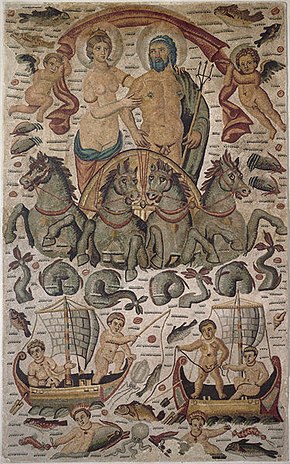Cirta

Detail of Triumph of Neptune and Amphitrite (ca. 315-325 AD), a vast Roman mosaic from Cirta. Now in the Louvre
|
|
| Location | Algeria |
|---|---|
| Region | Constantine Province |
| Coordinates | 36°22′03″N 6°36′43″E / 36.3675°N 6.611944°E |
Cirta (from Berber: KRTN or Kirthan,Phoenician: Tzirta) was the capital city of the Berber Kingdom of Numidia in northern Africa (modern Algeria). Its strategically important port city was Russicada. Although Numidia was a key ally of the ancient Roman Republic during the Punic Wars (264–146 BC), Cirta was subject to Roman invasions during the 1st and 2nd centuries BC. Eventually went under Roman dominion during the rule of Julius Caesar. Cirta was then repopulated by Roman colonists by Caesar and Augustus and was surrounded by a "Confederation of free Roman cities" (Tiddis, Cuicul, Milevum, etc.) The city was destroyed in the beginning of the 4th century and was rebuilt by the Roman emperor Constantine the Great, who gave his name to the newly constructed city, Constantine. Vandals damaged Cirta, but emperor Justinianus I reconquered and improved the Roman city. Arabs finally destroyed it in 698 AD, reducing the former Christian city to a small Moslem village that only after some centuries recovered some importance
Cirta was an important Roman colony in Africa, characterized by a full latinisation during the late Roman Empire: it was fully Latin speaking and Christian when the Vandals arrived in 430 AD, according to historian Theodore Mommsen. Pliny calls the city as the first century Roman colonia "Cirta Sittianorum", together with Rusicade, Milevum and Chullu in what was an autonomous territory of the new province Africa Nova.
...
Wikipedia

